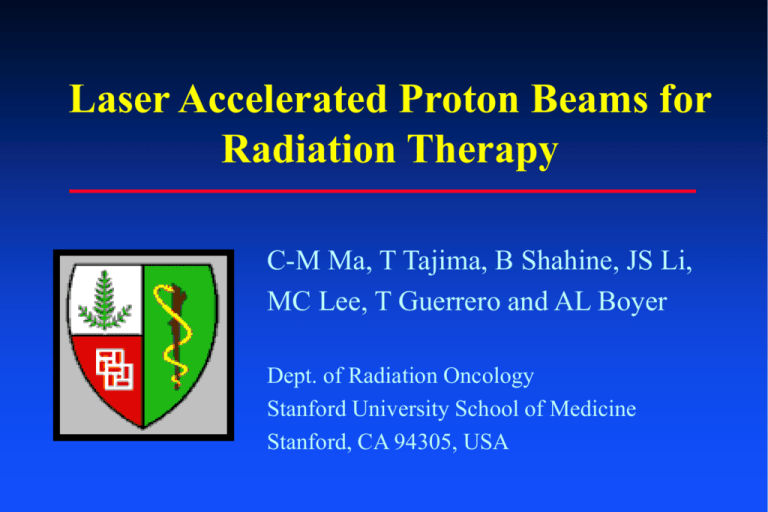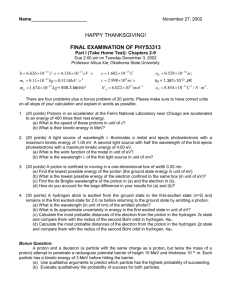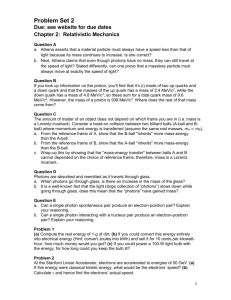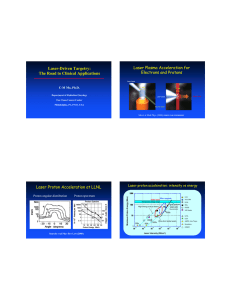sleeve correction factor - Harvard University Department of Physics
advertisement

Laser Accelerated Proton Beams for Radiation Therapy C-M Ma, T Tajima, B Shahine, JS Li, MC Lee, T Guerrero and AL Boyer Dept. of Radiation Oncology Stanford University School of Medicine Stanford, CA 94305, USA Why/Why Not Proton Beams? Advantageous dosimetry characteristics Expensive, cumbersome, inflexible Potential remains to be explored Laser Ion Acceleration q = 0.6 degrees Computational and experimental proton acceleration as a function of laser intensity (Zhidkov et al. 1999). Theoretical Results Particle in cell (PIC) simulation results (Ueshima 1999b) on ion and electron acceleration by laser irradiation on three thin targets. A laser intensity of 1021 W/cm2on the target surface is applied. Energy conversion Ion Electron Peak energy H+ Peak energy Al10+ Peak energy electron Average energy H+ Average energy Al10+ Case 1 50% 4% 48% 200 MeV 1 GeV 25 MeV 58 MeV 130 MeV Case 2 24% 8% 16% 400 MeV 2 GeV 15 MeV 95 MeV 500 MeV Case 3 31% 14% 17% 400 MeV 2 GeV 20 MeV 115 MeV 500 MeV Proton angular distribution Proton spectrum Energy Conversion and Dose Rate Total laser energy delivered on target per shot: 8J Total proton energy converted from laser (above MeV) 1J Total proton energy within a therapeutic energy window 0.01 – 0.1 J Dose per laser shot 1 – 10 Gy 3.5E+5 3.0E+5 Energy (MeV) 2.5E+5 2.0E+5 1.5E +5 1.0E +5 5.0E+4 0.0E+0 0 5 10 15 20 25 D epth (cm ) 30 35 40 Combined dose distribution Proton spectrum 6.0E +4 1 .6 4.0E +4 Probability Energy (MeV) 1 .2 0 .8 2.0E +4 0 .4 0 .0 0.0E +0 0 5 10 15 D epth (cm ) 20 25 30 80 100 120 140 160 E n e rg y (M e V ) 180 200 Comparison of Isodose Distribution Photon IMRT Modulated Proton beams Comparison of DVH Target DVH Rectum DVH Current Research at Stanford on Laser-Proton Beams Particle-in-cell (PIC) simulations of laser-ion interactions System design for a laser-proton therapy unit Software development for accurate and fast dose calculation Treatment optimization for energy-and intensitymodulated proton therapy (EIMPT) For detailed dose calculation and IMPT treatment optimization, please see: Jinsheng Li, et al., TU-C-BRA-06 Bilal Shahine et al, TU-C-BRA-07 The Stanford Monte Carlo Team Charlie Ma Gary Luxton David Findley Todd Koumrian Steve Jiang Jinsheng Li Eugene Fourkal Michael Luxton Michael Lee Jasjit Jolly Art Boyer Todd Pawlicki Ed Mok Sam Brain Thomas Guerrero Jun Deng Joerg Lehmann Meisong Ding Ajay Kapur Grisel Mora










